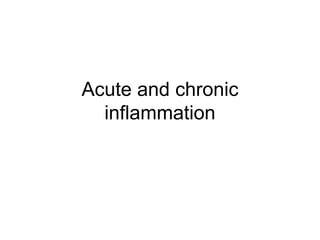
2 inflam
- 1. Acute and chronic inflammation
- 2. Inflammation (5 OBJECTIVES) 1) (Concept) Understand the chain, progression, or sequence of vascular and cellular events in the histologic evolution of acute inflammation
- 3. 2) (Rote?) Learn the roles of various “chemical mediators” of acute inflammation 3) Know the three possible outcomes of acute inflammation 4) Visualize the three morphologic patterns of acute inflammation 5) Understand the causes, morphologic patterns, principle cells, minor cells, of chronic and granulomatous inflammation
- 4. SEQUENCE OF EVENTS • NORMAL HISTOLOGY • VASODILATATION • INCREASED VASCULAR PERMEABILITY • LEAKAGE OF EXUDATE • MARGINATION, ROLLING, ADHESION • TRANSMIGRATION (DIAPEDESIS) • CHEMOTAXIS • PMN ACTIVATION • PHAGOCYTOSIS: Recognition, Attachment, Engulfment, Killing (degradation or digestion) • TERMINATION • 100% RESOLUTION, SCAR, or CHRONIC INFLAMMATION are the three possible outcomes
- 5. ACUTE INFLAMMATION • “PROTECTIVE” RESPONSE •NON-specific
- 6. ACUTE INFLAMMATION •VASCULAR EVENTS •CELLULAR EVENTS (PMN or PolyMorphonuclear Neutrophil, Leukocyte?, “POLY”, Neutrophil, Granulocyte, Neutrophilic Granulocyte • “MEDIATORS”
- 7. ACUTE INFLAMMATION Neutrophil Polymorphonuclear Leukocyte, PMN, PML “Leukocyte” Granulocyte, Neutrophilic granulocyte “Poly-” Polymorph
- 8. HISTORICAL HIGHLIGHTS (Egypt, 3000 BC) Rubor Calor Tumor Dolor 5th (functio laesa)
- 9. STIMULI for acute inflammation •INFECTIOUS •PHYSICAL •CHEMICAL • Tissue Necrosis • Foreign Bodies (FBs) • Immune “responses”, or “complexes”
- 10. Vascular Changes • Changes in Vascular Flow and Caliber • Increased Vascular Permeability
- 11. INCREASED PERMEABILITY •DILATATION • Endothelial “gaps” • Direct Injury • Leukocyte Injury • Transocytosis (endo/exo) • New Vessels
- 12. LEAKAGE OF PROTEINACEOUS FLUID (EXUDATE, NOT TRANSUDATE)
- 13. EXTRAVASATION of PMNs • MARGINATION (PMN’s go toward wall) • ROLLING (tumbling and HEAPING) • ADHESION • TRANSMIGRATION (DIAPEDESIS)
- 14. ADHESION MOLECULES (glycoproteins) affecting ADHESION and TRANSMIGRATION • SECRETINS (from endothelial cells) • INTEGRINS (from many cells)
- 15. CHEMOTAXIS PMNs going to the site of “injury” AFTER transmigration
- 16. LEUKOCYTE “ACTIVATION” • “triggered” by the offending stimuli for PMNs to: – 1) Produce eicosanoids (arachidonic acid derivatives) • Prostaglandin (and thromboxanes) • Leukotrienes • Lipoxins – 2) Undergo DEGRANULATION – 3) Secrete CYTOKINES
- 17. PHAGOCYTOSIS • RECOGNITION • ENGULFMENT • KILLING (DEGRADATION/ DIGESTION)
- 18. CHEMICAL MEDIATORS • From plasma or cells • Have “triggering” stimuli • Usually have specific targets • Can cause a “cascade” • Are short lived
- 19. CLASSIC MEDIATORS • HISTAMINE • SEROTONIN • COMPLEMENT • KININS • CLOTTING FACTORS • EICOSANOIDS • NITRIC OXIDE • PLATELET ACTIVATING FACTOR (PAF) • CYTOKINES • /CHEMOKINES • LYSOSOME CONSTITUENTS • FREE RADICALS • NEUROPEPTIDES
- 20. HISTAMINE • Mast Cells, basophils • POWERFUL Vasodilator • Vasoactive “amine” • IgE on mast cell
- 21. SEROTONIN • (5HT, 5-Hydroxy- Tryptamine) • Platelets and EnteroChromaffin Cells • Also vasodilatation, but more indirect • Evokes N.O. synthetase (a ligase)
- 22. COMPLEMENT SYSTEM • >20 components, in circulating plasma • Multiple sites of action, but LYSIS is the underlying theme
- 23. KININ SYSTEM • BRADYKININ is KEY component, 9 aa’s • ALSO from circulating plasma • ACTIONS – Increased permeability – Smooth muscle contraction, NON vascular –PAIN
- 24. CLOTTING FACTORS • Also from circulating plasma • Coagulation, i.e., production of fibrin • Fibrinolysis
- 26. EICOSANOIDS (ARACHIDONIC ACID DERIVATIVES) • Part of cell membranes • 1) Prostaglandins (incl. Thromboxanes) • 2) Leukotrienes • 3) Lipoxins (new) MULTIPLE ACTIONS AT MANY LEVELS
- 28. Prostaglandins (thromboxanes included) • Pain • Fever • Clotting
- 29. Leukotrienes • Chemotaxis • Vasodilatation • Increased Permeability
- 30. Lipoxins • INHIBIT chemotaxis • Vasoconstriction • Counteract actions of leukotrienes
- 31. Platelet-Activating Factor (PAF) • Phospholipid • From MANY cells, like eicosanoids • ACTIVATE PLATELETS, powerfully
- 32. CYTOKINES/CHEMOKINES • CYTOKINES are PROTEINS produced by MANY cells, but usually LYMPHOCYTES and MACROPHAGES, numerous roles in acute and chronic inflammation –TNFα, IL-1, by macrophages • CHEMOKINES are small proteins which are attractants for PMNs (>40)
- 33. NITRIC OXIDE • Potent vasodilator • Produced from the action of nitric oxide synthetase from arginine
- 34. LYSOSOMAL CONSTITUENTS • PRIMARY • Also called AZUROPHILIC, or NON-specific • Myeloperoxidase • Lysozyme (Bact.) • Acid Hydrolases • SECONDARY • Also called SPECIFIC • Lactoferrin • Lysozyme • Alkaline Phosphatase • Collagenase
- 35. FREE RADICALS • O2– (SUPEROXIDE) •H2O2 (PEROXIDE) •OH- (HYDROXYL RADICAL) •VERY VERY DESTRUCTIVE
- 36. NEUROPEPTIDES • Produced in CNS (neurons) • SUBSTANCE P • NEUROKININ A
- 37. OUTCOMES OF ACUTE INFLAMMATION • 1) 100% complete RESOLUTION • 2) SCAR • 3)CHRONIC inflammation
- 38. Morphologic PATTERNS of Acute INFLAMMATION (EXUDATE) •Serous (watery) •Fibrinous (hemorrhagic, rich in FIBRIN) •Suppurative (PUS) •Ulcerative
- 39. BLISTER, “Watery”, i.e., SEROUS
- 40. FIBRINOUS
- 41. PUS = PURULENT ABSCESS = POCKET OF PUS
- 43. ULCERATIVE
- 44. SEQUENCE OF EVENTS • NORMAL HISTOLOGY • VASODILATATION • INCREASED VASCULAR PERMEABILITY • LEAKAGE OF EXUDATE • MARGINATION, ROLLING, ADHESION • TRANSMIGRATION (DIAPEDESIS) • CHEMOTAXIS • PMN ACTIVATION • PHAGOCYTOSIS: Recognition, Attachment, Engulfment, Killing (degradation or digestion) • TERMINATION • 100% RESOLUTION, SCAR, or CHRONIC inflammation
- 45. CHRONIC INFLAMMATION (MONOS) LYMPHOCYTE MONOCYTE MACROPHAGE HISTIOCYTE
- 46. CAUSES of CHRONIC INFLAMMATION • 1) PERSISTENCE of Infection • 2) PROLONGED EXPOSURE to insult • 3) AUTO-IMMUNITY
- 47. Cellular Players •LYMPHOCYTES •MACROPHAGES (aka, HISTIOCYTES) • PLASMA CELLS • EOSINOPHILS • MAST CELLS
- 48. MORPHOLOGY • INFILTRATION • TISSUE DESTRUCTION •HEALING
- 49. GRANULOMAS GRANULOMATOUS INFLAMMATION 4 COMPONENTS FIBROBLASTS LYMPHS HISTIOS “GIANT” CELLS
- 50. GRANULOMAS GRANULOMATOUS INFLAMMATION CASEATING (TB) NON-CASEATING
- 51. LYMPHATIC DRAINAGE • SITE REGIONAL LYMPH NODES
- 52. SYSTEMIC MANIFESTATIONS (NON-SPECIFIC) • FEVER, CHILLS • C-Reactive Protein (CRP) • “Acute Phase” Reactants • Erythrocyte Sedimentation Rate (ESR) increases • Leukocytosis • Pulse, Blood Pressure • Cytokine Effects, e.g., TNF(α), IL-1
- 53. NORMAL SPE Serum Protein Electrophoresis In ACUTE Inflammation Alpha-1 & alpha-2 are increased, i.e., “acute phase” reactants.
